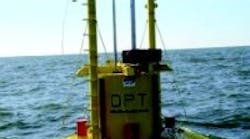In today's world, we depend primarily on non-renewable energy sources that have unstable prices and cause damage to the environment. Ocean Power Technologies Inc., Pennington, N.J., has developed a way to harness the power of the ocean— a clean power generation technology that is better for the environment.
OPT's PowerBuoy system is based on the integration of patented technologies in hydrodynamics, electronics, conversion mechanics, and computer control systems. The PowerBuoy uses the motion of the waves to extend and retract the piston rod of a hydraulic cylinder.
This mechanical stroking drives an electric generator. The AC power generated is converted into high-voltage DC power and transmitted ashore via an underwater cable. Multiple buoys can be deployed in arrays scalable to hundreds of megawatts. Thus far, the system has under-gone testing in both the Atlantic and Pacific oceans.
The hydraulic connection
Officials at Ocean Power Technologies would not provide details of the hydraulics used in their system, but similar systems have been built that fix a cylinder to or near the ocean floor. When a wave elevates the buoy, a rod attached to the buoy and the piston rod end pulls the piston rod up. When the wave recedes, the weight of the buoy then pushes the piston rod back into the cylinder. A series of check valves could route fluid from multiple cylinders into a hydraulic motor, which would drive a generator.
Another scenario would simply connect the rod-and cap-end ports of the cylinder to respective ports of a bi-directional hydraulic motor. Rod extension would rotate the motor shaft in one direction, and rod retraction would rotate it in the opposite direction. Connecting the motor shaft to a generator would produce the AC power.
Although a novel design idea, certain challenges are inherent to a hydraulic system in the middle of the ocean. The system is isolated, and not easy to service on a regular basis. Plus, leakage of conventional hydraulic fluid cannot be tolerated. Such potential leakage would certainly throw up red flags to any states or countries that would install the buoys offshore.
OPT solved these challenges by using Cosmolubric TR 2000 hydraulic fluid, manufactured by Houghton International, Valley Forge, Pa. Cosmolubric TR 2000 is an environmentally friendly, renewable resource which disperses in water. Therefore, it will not create an oil slick, a perfect fit for the WaveBuoy system.
Cosmolubric TR 2000 is an emulsifiable hydraulic oil, formulated from vegetable oil and ashless, zinc-free additives. The fluid is based on biodegradable esters to provide environmental benefits compared to mineral oil. The fluid was formulated to be used in hydraulic and mechanical equipment that is vulnerable to water contamination.
Conventional lubricating oils do little to prevent damage by water contamination because they read-ily separate from water, leaving pools of water in the system. These pools of free water can cause rust and corrosion in the system. The additive package formulated in Cosmolubric TR 2000 gives it the ability to emulsify fresh or sea water, while providing exceptional anti-corrosion properties for the internal protection of the hydraulic system.
Benefits include:
- biodegradable
- contains no meta-based additives
- achieves long fluid life
- will emulsify into fresh or salt water
- passes standard pump tests
- complete compatibility with metals
- compatible with most standard seal materials.
For more information on Cosmolubric TR 2000, contact Houghton International at (610) 666-4000, or visit www.houghtonintl.com


